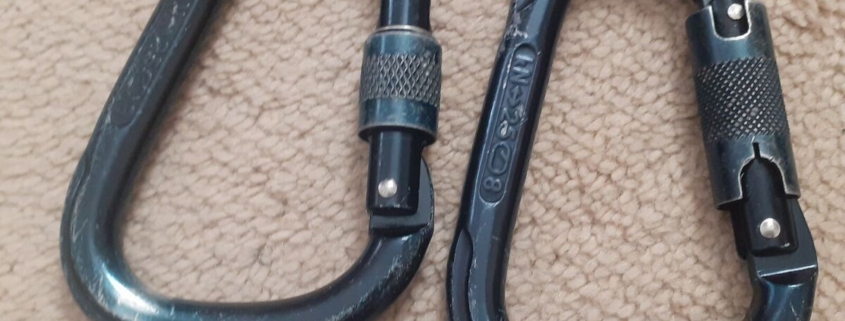Help, I’m Stuck!: A Basic Guide For Carabiner Care.
Help, I’m Stuck!: A Basic Guide For Carabiner Care
Carabiners play a vital role in any tree climber’s kit, serving as the linchpin that connects various elements of the climbing system. Whether you’re a seasoned climber or a beginner eager to get off the ground, developing an understanding of how to properly use, maintain, and care for your climbing carabiners is crucial for safety and performance. In this blog, we’ll delve into the intricacies of these vital pieces of kit, and it will apply to both climbing carabiners and rigging carabiners.
As you may already know, it is recommended to inspect your equipment every time before going aloft, especially if the equipment hasn’t been used in a while. Here are a few things to look for during the inspection process:
Help, I’m Stuck!: A Basic Guide For Carabiner Care
- Visually inspect the carabiner’s body for abrasion, sharp edges, excessive wear, corrosion, or deformation. An aluminum carabiner that has been exposed to extreme rigging forces or when used for wild mechanical advantage configurations can begin to “stretch”.
- Be on the lookout for burrs, these little imperfections can happen quite easily and can damage your rope.
- Hairline cracks can be found in carabiners and can reduce carabiner strength, however spotting that defect might require closer attention, so bust out those bifocals!
- Lastly (for the visual inspection), make sure the rivets are still intact and in good condition.
Following the visual inspection, proceed to the functions test, which will include the following:
- Open the carabiner gate all the way to the spine without excessive force and allow the gate to close without any interference from the fingers. If your carabiner opens offset of the spine, don’t worry. Certain carabiners are designed to open that way.
- During this step, you can also check the alignment of the nose and the nose slot on the barrel of the gate.
- During this step, you can also check the alignment of the nose and the nose slot on the barrel of the gate.
- Next – open the gate just slightly before the half-way point and, without interference, allow the gate to close on its own.
- During this step, while the gate is open, gently wiggle the gate and look for excessive movement.
- During this step, while the gate is open, gently wiggle the gate and look for excessive movement.
- Lastly – open the gate to half-way across the nose and release the gate. It should automatically close.
If at any point the gate does not automatically spring toward the nose, the gate does not close, or if there sounds like there’s sandpaper scratching on the inside; it is time to clean the carabiner.
Clean and Lubrication
Follow these simple steps to get that carabiner shiny once again:
- Remove the loose excess dirt/debris from the carabiner.
- In a container, fill it with lukewarm water and add neutral ph detergent.
- Proceed to submerge the carabiner in the cleaning water, open and close the gate to work the muck out of the barrel.
- Once you believe the muck is removed from the internals, dump the grimy water from the container and refill it with clean water. Continue to open and close the carabiner in order to completely flush out any cleaning solution left in the barrel.
- Drying out the carabiner is simple; hang dry the carabiner or to speed up the process, use compressed air set to the lowest pressure possible and carefully blow the barrel dry. If too high of pressure is used, the internal springs may become damaged and will cause you to retire the carabiner. Hang the carabiner with the gate opening facing upwards, this way the barrel containing the spring is able to drain out.
- Lubricate only when the carabiner is completely dry. Most manufacturers will recommend using Duck Oil or 3-in-1; stay away from WD40 and dry graphite powder as they are not truly lubricants. The dry graphite powder may collect and build up debris, making it a meticulous cleaning.
-
Most carabiners will have three different springs working the barrel/gate. To hit the rotation spring, sparingly apply (the correct) lubrication to the small opening of the barrel towards the gate opening.
-
Next, we’ll hit the compression spring. At the hinge, we’ll pull the barrel away from the hinge and lubricate. We will do this on both sides, and we’ll also lubricate the hinge while were there.
-
Finally, we’ll rotate the barrel in order to access the innermost compression spring and lubricate as well.
-
-
At this point, wipe away any excess lubrication and repeat the functions test. If any flaw is still present, hate to say it but it’s time to retire said carabiner.
Some people wonder how to fix a carabiner. If you notice damage in your carabiner, you need to retire it. It is unsafe to attempt to fix or repair an arborist carabiner.
Bartlett Arborist Supply has a wide selection of carabiners when you need to replace your current carabiner. We also can recommend what carabiner you need for the job.
Take care of your equipment and it will take care of you. I do understand that certain environments will degrade our tree climbing carabiners no matter how delicate we may be with our equipment, but that is no reason to skimp on performing gear inspection. Climb safe!



Leave a Reply
Want to join the discussion?Feel free to contribute!